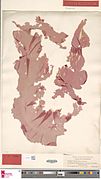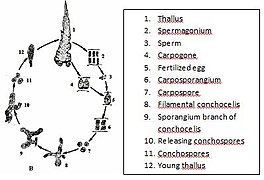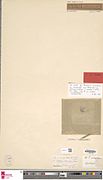Pyropia: Difference between revisions
Narky Blert (talk | contribs) Link to surname page -> redlink |
I lengthened the lead on the page and added sections for taxonomy, description, distribution, and use. |
||
| Line 1: | Line 1: | ||
'''''Pyropia''''' is a genus of [[Red algae|red alga]] [seaweed] in the [[Bangiaceae]] family. It is found around the world in intertidal zones and shallow water. The genus has folding frond like blades which are either red, brown or green. Some Pyropia species are used to create nori and are thus a popular aquaculture. |
|||
{{automatic taxobox |
{{automatic taxobox |
||
| image = Porphyra yezoensis.jpg |
| image = Porphyra yezoensis.jpg |
||
| Line 81: | Line 83: | ||
}} |
}} |
||
== '''Taxonomy''' == |
|||
'''''Pyropia''''' is a genus of [[red algae]] in the [[Bangiaceae]] family. Many species in ''Pyropia'' were formerly placed in ''[[Porphyra]]''. |
|||
'''''Pyropia''''' was originally discovered by Jacob Georg Agardh, a botanist and professor at Lund University. Before it was discovered and sometime after many species of Pyropia were placed into Porphyra, a different genus of red alga. Still, new species of Pyropia is being discovered. Just recently in 2013 research done in New Zealand was able to name '''''Pyropia''''' ''plicata'', previously mistaken for another species of [[Porphyra]] <ref>{{Cite journal|last=Nelson|first=Wendy A.|date=2013-03-22|title=Pyropia plicata sp. nov. (Bangiales, Rhodophyta): naming a common intertidal alga from New Zealand|url=https://www.ncbi.nlm.nih.gov/pmc/articles/PMC3689116/|journal=PhytoKeys|issue=21|pages=17–28|doi=10.3897/phytokeys.21.4614|issn=1314-2011|pmc=PMCPMC3689116|pmid=23794933}}</ref>. |
|||
== '''Description''' == |
|||
Pyropia is a red alga with a discoid [[holdfast]] and short stipe. It has folded blades, which are membranous and monostromatic [thin and membrane like], coming in red, brown, and dark green colorations. These folded blades may also look like fronds until unfolded. These blades reach up to one meter in length in some species but are generally found around 20 centimeters in diameter. |
|||
== '''Distribution''' == |
|||
Pyropia grows in intertidal zones and down to 10 meters in some bodies of water based on clarity and substrate <ref name=":0">{{Cite journal|last=Qian|first=Feijian|last2=Luo|first2=Qijun|last3=Yang|first3=Rui|last4=Zhu|first4=Zhujun|last5=Chen|first5=Haimin|last6=Yan|first6=Xiaojun|date=2015-2|title=The littoral red alga Pyropia haitanensis uses rapid accumulation of floridoside as the desiccation acclimation strategy|url=http://link.springer.com/10.1007/s10811-014-0336-0|journal=Journal of Applied Phycology|language=en|volume=27|issue=1|pages=621–632|doi=10.1007/s10811-014-0336-0|issn=0921-8971}}</ref>. It grows in large swaths, attaching itself to stones and shells, covering most of the bottom. Pyropia can be found globally in in warm-temperate and extratropical [cool] waters. |
|||
=== '''Ecology''' === |
|||
Pyropia, which reside in the upper intertidal zone, endure many stresses including – intense direct-light, temperature fluctuation, osmotic stress, salinity fluctuation, and desiccation. It is great at handling the stress of heat; Some Pyropia species will halt non-essential systems to homeostasis like photosynthesis and other processes <ref>{{Cite journal|last=Xu|first=Yan|last2=Chen|first2=Changsheng|last3=Ji|first3=Dehua|last4=Hang|first4=Nan|last5=Xie|first5=Chaotian|date=2014-2|title=Proteomic profile analysis of Pyropia haitanensis in response to high-temperature stress|url=http://link.springer.com/10.1007/s10811-013-0066-8|journal=Journal of Applied Phycology|language=en|volume=26|issue=1|pages=607–618|doi=10.1007/s10811-013-0066-8|issn=0921-8971}}</ref>. Other species will use increased lipid production to fight desiccation <ref name=":0" />. Pyropia’s to adapt to deal with these stresses making it a heavily studied organism. |
|||
One of the threats to Pyropia is fungal infections by ''[[Alternaria]] sp. ZL-1,'' which has been observed in farming environments on ''Pyropia yezoensis'' <ref>{{Cite web|url=https://www.researchgate.net/publication/273509365_Characterization_of_a_novel_fungal_disease_that_infects_the_gametophyte_of_Pyropia_yezoensis_Bangiales_Rhodophyta|title=Characterization of a novel fungal disease that infects the gametophyte of Pyropia yezoensis (Bangiales, Rhodophyta)|last=Mo1 Li2 Kong3 Tang4 Mao5|first=Zhaolan1 Shufan2 Fanna3 Xianghai4 Yunxiang5|date=|website=https://www.researchgate.net|archive-url=|archive-date=2015|dead-url=|access-date=}}</ref>''.'' The fungus kills Pyropia cells and leaves brown rust looking spots on the outside of the blades. |
|||
== Use == |
|||
Within the genus Pyropia multiple species are used for nori (edible seaweed), ''Pyropia yezoensis'' and ''P. haitanensis'' are of the most popular <ref>{{Cite journal|last=Xie|first=Chaotian|last2=Li|first2=Bing|last3=Xu|first3=Yan|last4=Ji|first4=Dehua|last5=Chen|first5=Changsheng|date=2013-02-16|title=Characterization of the global transcriptome for Pyropia haitanensis (Bangiales, Rhodophyta) and development of cSSR markers|url=https://www.ncbi.nlm.nih.gov/pmc/articles/PMC3626662/|journal=BMC Genomics|volume=14|pages=107|doi=10.1186/1471-2164-14-107|issn=1471-2164|pmc=PMCPMC3626662|pmid=23414227}}</ref>. It is a two-billion-dollar industry with most major growers located in China, Korea, and Japan. |
|||
==Gallery== |
==Gallery== |
||
<gallery mode=packed> |
<gallery mode="packed"> |
||
File:Naturalis Biodiversity Center - L.4084188 - Porphyra thuretii Setch. and E.Y.Dawson - Algae - Plant type specimen.jpeg |
File:Naturalis Biodiversity Center - L.4084188 - Porphyra thuretii Setch. and E.Y.Dawson - Algae - Plant type specimen.jpeg |
||
File:Porphyra haitanensis life cycle.JPG |
File:Porphyra haitanensis life cycle.JPG |
||
| Line 91: | Line 110: | ||
==References== |
==References== |
||
{{Reflist}} |
{{Reflist}}<br /> |
||
==External links== |
==External links== |
||
Revision as of 20:31, 5 April 2019
Pyropia is a genus of red alga [seaweed] in the Bangiaceae family. It is found around the world in intertidal zones and shallow water. The genus has folding frond like blades which are either red, brown or green. Some Pyropia species are used to create nori and are thus a popular aquaculture.
Taxonomy
Pyropia was originally discovered by Jacob Georg Agardh, a botanist and professor at Lund University. Before it was discovered and sometime after many species of Pyropia were placed into Porphyra, a different genus of red alga. Still, new species of Pyropia is being discovered. Just recently in 2013 research done in New Zealand was able to name Pyropia plicata, previously mistaken for another species of Porphyra [3].
Description
Pyropia is a red alga with a discoid holdfast and short stipe. It has folded blades, which are membranous and monostromatic [thin and membrane like], coming in red, brown, and dark green colorations. These folded blades may also look like fronds until unfolded. These blades reach up to one meter in length in some species but are generally found around 20 centimeters in diameter.
Distribution
Pyropia grows in intertidal zones and down to 10 meters in some bodies of water based on clarity and substrate [4]. It grows in large swaths, attaching itself to stones and shells, covering most of the bottom. Pyropia can be found globally in in warm-temperate and extratropical [cool] waters.
Ecology
Pyropia, which reside in the upper intertidal zone, endure many stresses including – intense direct-light, temperature fluctuation, osmotic stress, salinity fluctuation, and desiccation. It is great at handling the stress of heat; Some Pyropia species will halt non-essential systems to homeostasis like photosynthesis and other processes [5]. Other species will use increased lipid production to fight desiccation [4]. Pyropia’s to adapt to deal with these stresses making it a heavily studied organism.
One of the threats to Pyropia is fungal infections by Alternaria sp. ZL-1, which has been observed in farming environments on Pyropia yezoensis [6]. The fungus kills Pyropia cells and leaves brown rust looking spots on the outside of the blades.
Use
Within the genus Pyropia multiple species are used for nori (edible seaweed), Pyropia yezoensis and P. haitanensis are of the most popular [7]. It is a two-billion-dollar industry with most major growers located in China, Korea, and Japan.
Gallery
References
- ^ Agardh, J.G. (1899). Analecta algologica, Continuatio V. Lunds Universitets Års-Skrift, Andra Afdelningen, Kongl. Fysiografiska Sällskapets i Lund Handlingar 35(4): 1-160, 3 pls.
- ^ M.D. Guiry in Guiry, M.D. & Guiry, G.M. 2017. AlgaeBase. World-wide electronic publication, National University of Ireland, Galway. http://www.algaebase.org/search/genus/detail/?genus_id=Na8c54bc5b1ee2bda&- searched on 15 September 2017.
- ^ Nelson, Wendy A. (2013-03-22). "Pyropia plicata sp. nov. (Bangiales, Rhodophyta): naming a common intertidal alga from New Zealand". PhytoKeys (21): 17–28. doi:10.3897/phytokeys.21.4614. ISSN 1314-2011. PMC PMCPMC3689116. PMID 23794933.
{{cite journal}}: Check|pmc=value (help)CS1 maint: unflagged free DOI (link) - ^ a b Qian, Feijian; Luo, Qijun; Yang, Rui; Zhu, Zhujun; Chen, Haimin; Yan, Xiaojun (2015-2). "The littoral red alga Pyropia haitanensis uses rapid accumulation of floridoside as the desiccation acclimation strategy". Journal of Applied Phycology. 27 (1): 621–632. doi:10.1007/s10811-014-0336-0. ISSN 0921-8971.
{{cite journal}}: Check date values in:|date=(help) - ^ Xu, Yan; Chen, Changsheng; Ji, Dehua; Hang, Nan; Xie, Chaotian (2014-2). "Proteomic profile analysis of Pyropia haitanensis in response to high-temperature stress". Journal of Applied Phycology. 26 (1): 607–618. doi:10.1007/s10811-013-0066-8. ISSN 0921-8971.
{{cite journal}}: Check date values in:|date=(help) - ^ Mo1 Li2 Kong3 Tang4 Mao5, Zhaolan1 Shufan2 Fanna3 Xianghai4 Yunxiang5. "Characterization of a novel fungal disease that infects the gametophyte of Pyropia yezoensis (Bangiales, Rhodophyta)". https://www.researchgate.net.
{{cite web}}:|archive-date=requires|archive-url=(help); Check date values in:|archive-date=(help); Cite has empty unknown parameter:|dead-url=(help); External link in|website= - ^ Xie, Chaotian; Li, Bing; Xu, Yan; Ji, Dehua; Chen, Changsheng (2013-02-16). "Characterization of the global transcriptome for Pyropia haitanensis (Bangiales, Rhodophyta) and development of cSSR markers". BMC Genomics. 14: 107. doi:10.1186/1471-2164-14-107. ISSN 1471-2164. PMC PMCPMC3626662. PMID 23414227.
{{cite journal}}: Check|pmc=value (help)CS1 maint: unflagged free DOI (link)
External links




